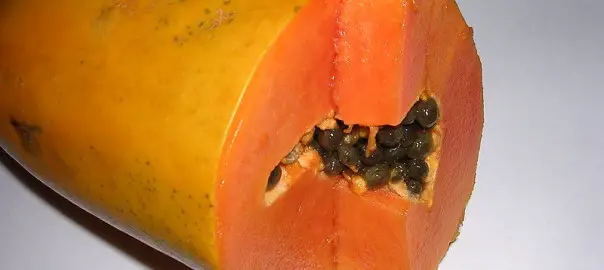Papayas are native to the Americas but have gradually been brought to the rest of the world to appreciate.
They can be used as a food, a cooking aid and in traditional medicine.
So can guinea pigs eat papaya and if they can how much of them can they eat?
image wikipedia
Let’s take a look at their nutritional data to find out a bit more about them
As per usual, we’ll take a look at their phosphorus, fat, sugar, acidic and calcium content because they are most pertinent to guinea pigs.
A good amount of vitamin A and c would also be beneficial.
Papayas, raw
Nutritional value per 100 g (3.5 oz)
Energy 179 kJ (43 kcal)
Carbohydrates 10.82 g
– Sugars 7.82 g
– Dietary fiber 1.7 g
Fat 0.26 g
Protein 0.47 g
Vitamin A equiv. 47 μg (6%)
– beta-carotene 274 μg (3%)
– lutein and zeaxanthin 89 μg
Thiamine (vit. B1) 0.023 mg (2%)
Riboflavin (vit. B2) 0.027 mg (2%)
Niacin (vit. B3) 0.357 mg (2%)
Pantothenic acid (B5) 0.191 mg (4%)
Vitamin B6 0.038 mg (3%)
Folate (vit. B9) 38 μg (10%)
Vitamin C 62 mg (75%)
Vitamin E 0.3 mg (2%)
Vitamin K 2.6 μg (2%)
Calcium 20 mg (2%)
Iron 0.25 mg (2%)
Magnesium 21 mg (6%)
Manganese 0.04 mg (2%)
Phosphorus 10 mg (1%)
Potassium 182 mg (4%)
Sodium 8 mg (1%)
Zinc 0.08 mg (1%)
Lycopene 1828 µg
Link to USDA Database entry
Percentages are roughly approximated
using US recommendations for adults.
Source: USDA Nutrient Database
source wikipedia
As you can see, papaya contains a hint of phosphorus, calcium and fat. However it is quite sweet and acidic which is do detriment to guinea pigs.
However it does contain a very good amount of vitamin c which is brilliant for guinea pigs.
This means that guinea pigs can eat papaya, in fact two to three times a week because it doesn’t contain a great deal of sugar and acid to be really concerned about them.
But because of the fantastic vitamin c content, papayas are a great fruit for guinea pigs to eat and a terrific addition to their diet.
Before feeding them papaya, make sure that you cut it up and get rid of the rind though and the seed, and only serve the flesh.
